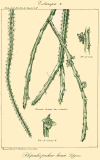Body - creeping
to pendant, branching irregularly, never whorled.
Shoots - vanable in shape and colour; terete to angular
to ± cylindric.
Areoles - . with felt and bristles, these later
disappearing.
Flowers - lateral, rotate, small, ± light pinkish-red.
Fruit - spherical, red.
Notes from Bradleya 13
This species is
easily separated from its closest relatives by having mature stem-segments
of indeterminate growth, which only rarely develop properly formed
terminal composite areoles. The two subspecies recognized are connected
by intermediates and together provide a rather unexpected link between
R. paradoxa on the one hand and R. pentaptera on the
other.
subspecies pacheco-leonis
This subspecies
is known from the municipios of Macae, Cabo Frio and Rio de Janeiro
(Pedra da Gavea), within the state of Rio de Janeiro. It has more
strongly succulent stems with only weakly developed angles and was
confused with the superficially similar R. dissimilis by Britton
& Rose (1923).
Desc from Hunt 2006.
Body pendent up to 2m; branch segments all of indeterminate growth,
arising subacrotonically, ca 7mm diam, (ssp. pacheco-leonis
± terete, with low rounded podaria, superficially resembles
R. lindbergiana, but with coloured flowers); scales marking
the areoles ca 1cm apart, subtended by slightly raised, rounded podaria
or these winglike; areoles apparent only after flowering, woolly and
sometimes bristly, up to 3mm diam; flowers up to 10mm diam, brownish
or pinkish; pericarp with extrafloral nectaries; fruit 5x4.5mm, red
or white with a pinkish ring around the tepal remnant scar.
subspecies. catenulata (Kimnach) Barthlott
& N.P. Taylor in Bradleya 13 (1995)
DISTRIBUTION. Brazil (S Espirito Santo, E Rio de Janeiro): perhumid
Atlantic rainforest.
The form from Espirito Santo (Mun. Domingos Martins, Rauh 67560, BONN!)
pro¬vides a clear morphological link to R. pen¬taptera A.
Dietrich, which, however, has stem-segments of determinate growth.
Desc from Hunt 2006.
Branch segments variably winged beneath the areoles.
Like a dwarf R. paradoxa ssp. septentrionalis or R. pentaptera
, but with branch segments of indeterminate growth
 Drawing
from Archivos do Jardim Botanico do Rio de Janeiro Vol II, 1918.
Drawing
from Archivos do Jardim Botanico do Rio de Janeiro Vol II, 1918.